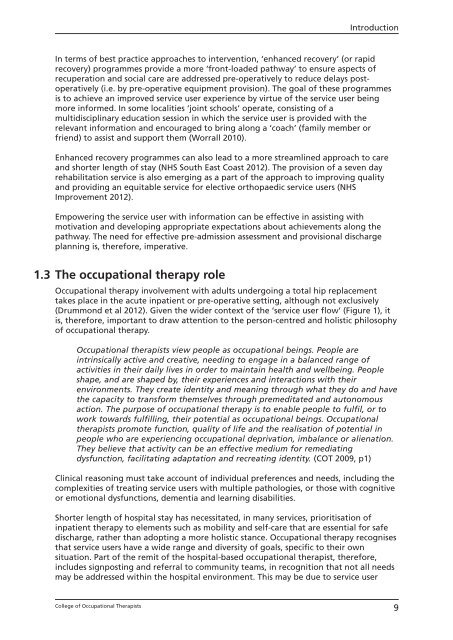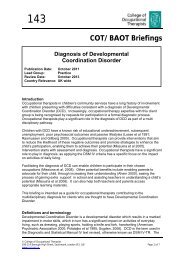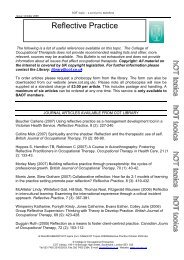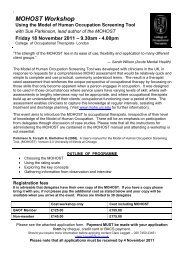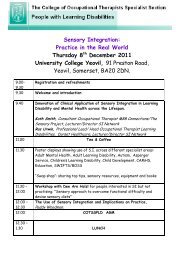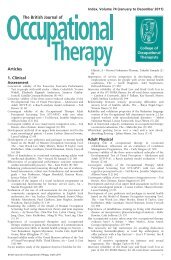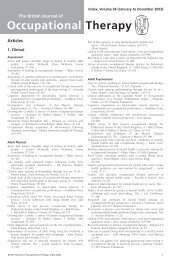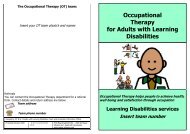Total hip replacement - College of Occupational Therapists
Total hip replacement - College of Occupational Therapists
Total hip replacement - College of Occupational Therapists
Create successful ePaper yourself
Turn your PDF publications into a flip-book with our unique Google optimized e-Paper software.
Introduction<br />
In terms <strong>of</strong> best practice approaches to intervention, ‘enhanced recovery’ (or rapid<br />
recovery) programmes provide a more ‘front- loaded pathway’ to ensure aspects <strong>of</strong><br />
recuperation and social care are addressed pre- operatively to reduce delays postoperatively<br />
(i.e. by pre- operative equipment provision). The goal <strong>of</strong> these programmes<br />
is to achieve an improved service user experience by virtue <strong>of</strong> the service user being<br />
more informed. In some localities ‘joint schools’ operate, consisting <strong>of</strong> a<br />
multidisciplinary education session in which the service user is provided with the<br />
relevant information and encouraged to bring along a ‘coach’ (family member or<br />
friend) to assist and support them (Worrall 2010).<br />
Enhanced recovery programmes can also lead to a more streamlined approach to care<br />
and shorter length <strong>of</strong> stay (NHS South East Coast 2012). The provision <strong>of</strong> a seven day<br />
rehabilitation service is also emerging as a part <strong>of</strong> the approach to improving quality<br />
and providing an equitable service for elective orthopaedic service users (NHS<br />
Improvement 2012).<br />
Empowering the service user with information can be effective in assisting with<br />
motivation and developing appropriate expectations about achievements along the<br />
pathway. The need for effective pre- admission assessment and provisional discharge<br />
planning is, therefore, imperative.<br />
1.3 The occupational therapy role<br />
<strong>Occupational</strong> therapy involvement with adults undergoing a total <strong>hip</strong> <strong>replacement</strong><br />
takes place in the acute inpatient or pre- operative setting, although not exclusively<br />
(Drummond et al 2012). Given the wider context <strong>of</strong> the ‘service user flow’ (Figure 1), it<br />
is, therefore, important to draw attention to the person- centred and holistic philosophy<br />
<strong>of</strong> occupational therapy.<br />
<strong>Occupational</strong> therapists view people as occupational beings. People are<br />
intrinsically active and creative, needing to engage in a balanced range <strong>of</strong><br />
activities in their daily lives in order to maintain health and wellbeing. People<br />
shape, and are shaped by, their experiences and interactions with their<br />
environments. They create identity and meaning through what they do and have<br />
the capacity to transform themselves through premeditated and autonomous<br />
action. The purpose <strong>of</strong> occupational therapy is to enable people to fulfil, or to<br />
work towards fulfilling, their potential as occupational beings. <strong>Occupational</strong><br />
therapists promote function, quality <strong>of</strong> life and the realisation <strong>of</strong> potential in<br />
people who are experiencing occupational deprivation, imbalance or alienation.<br />
They believe that activity can be an effective medium for remediating<br />
dysfunction, facilitating adaptation and recreating identity. (COT 2009, p1)<br />
Clinical reasoning must take account <strong>of</strong> individual preferences and needs, including the<br />
complexities <strong>of</strong> treating service users with multiple pathologies, or those with cognitive<br />
or emotional dysfunctions, dementia and learning disabilities.<br />
Shorter length <strong>of</strong> hospital stay has necessitated, in many services, prioritisation <strong>of</strong><br />
inpatient therapy to elements such as mobility and self- care that are essential for safe<br />
discharge, rather than adopting a more holistic stance. <strong>Occupational</strong> therapy recognises<br />
that service users have a wide range and diversity <strong>of</strong> goals, specific to their own<br />
situation. Part <strong>of</strong> the remit <strong>of</strong> the hospital- based occupational therapist, therefore,<br />
includes signposting and referral to community teams, in recognition that not all needs<br />
may be addressed within the hospital environment. This may be due to service user<br />
<strong>College</strong> <strong>of</strong> <strong>Occupational</strong> <strong>Therapists</strong><br />
9


